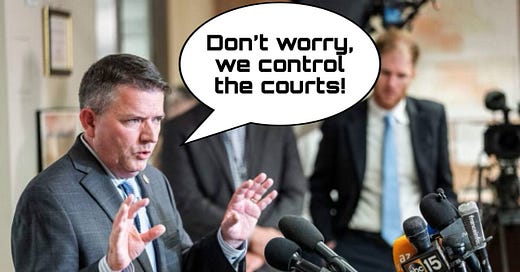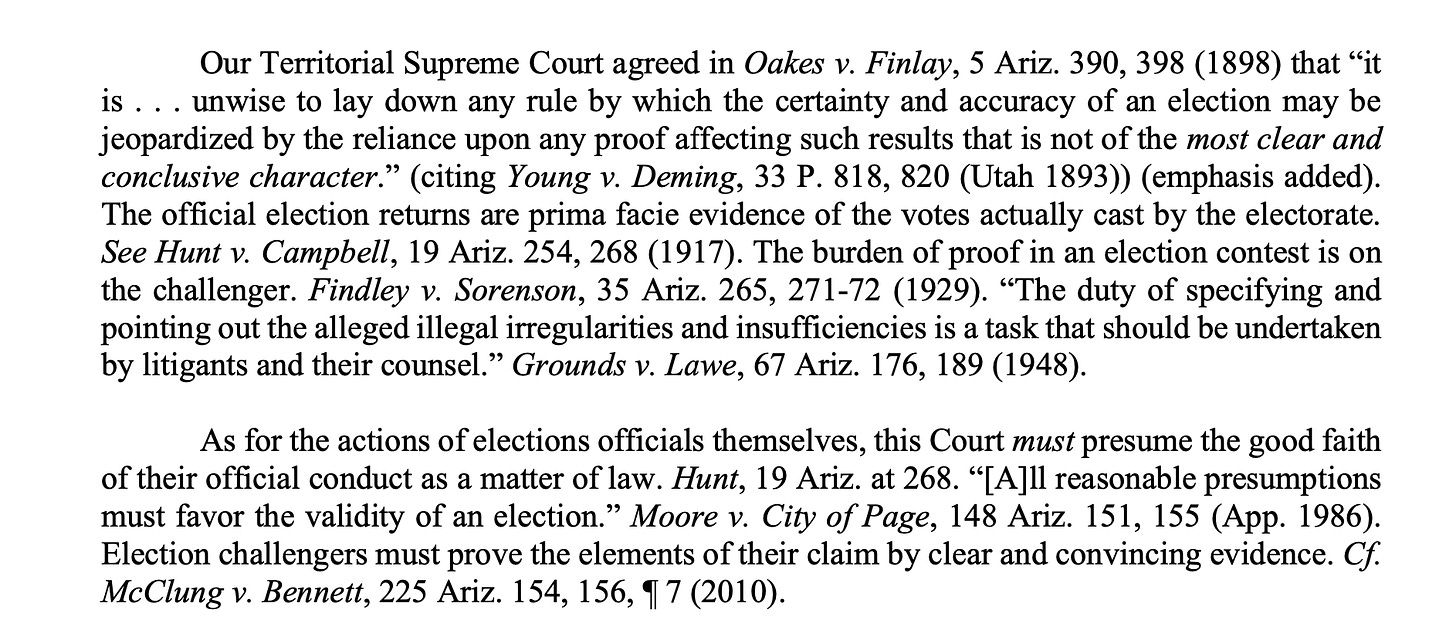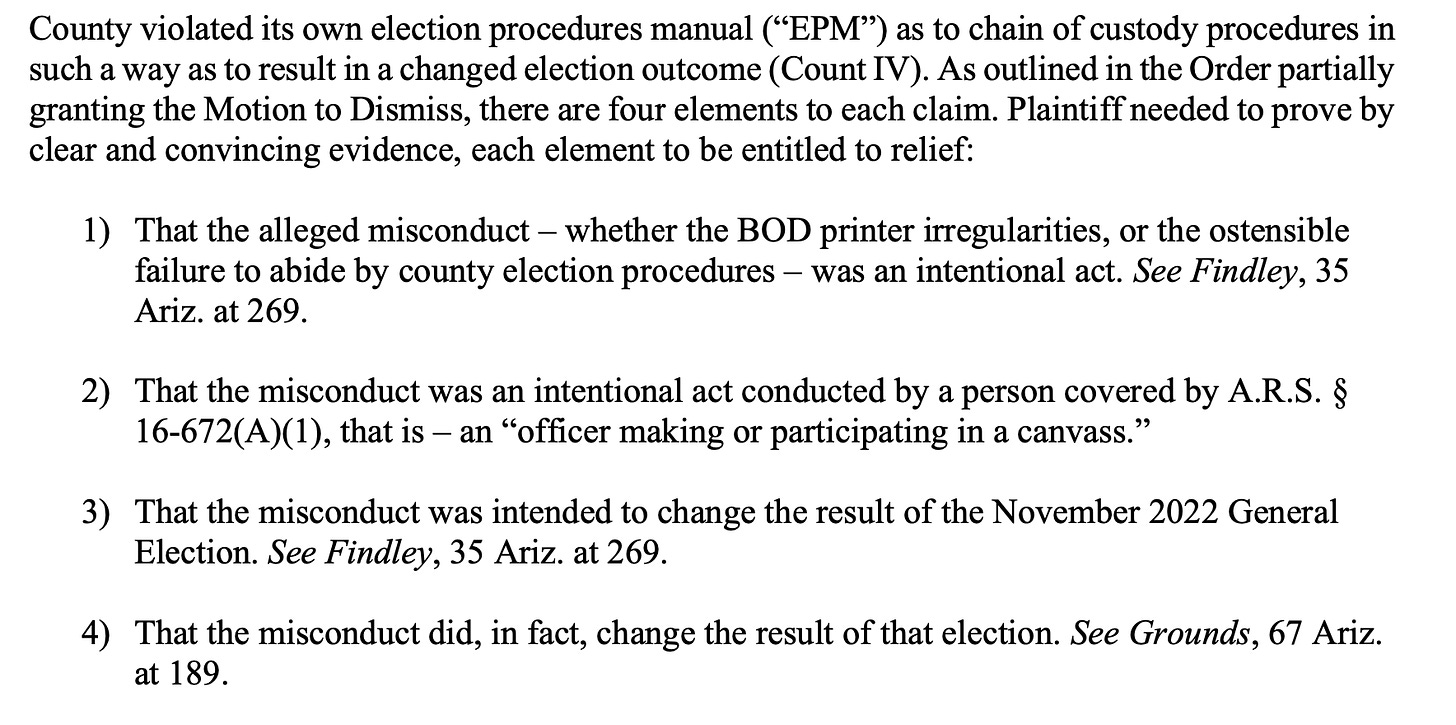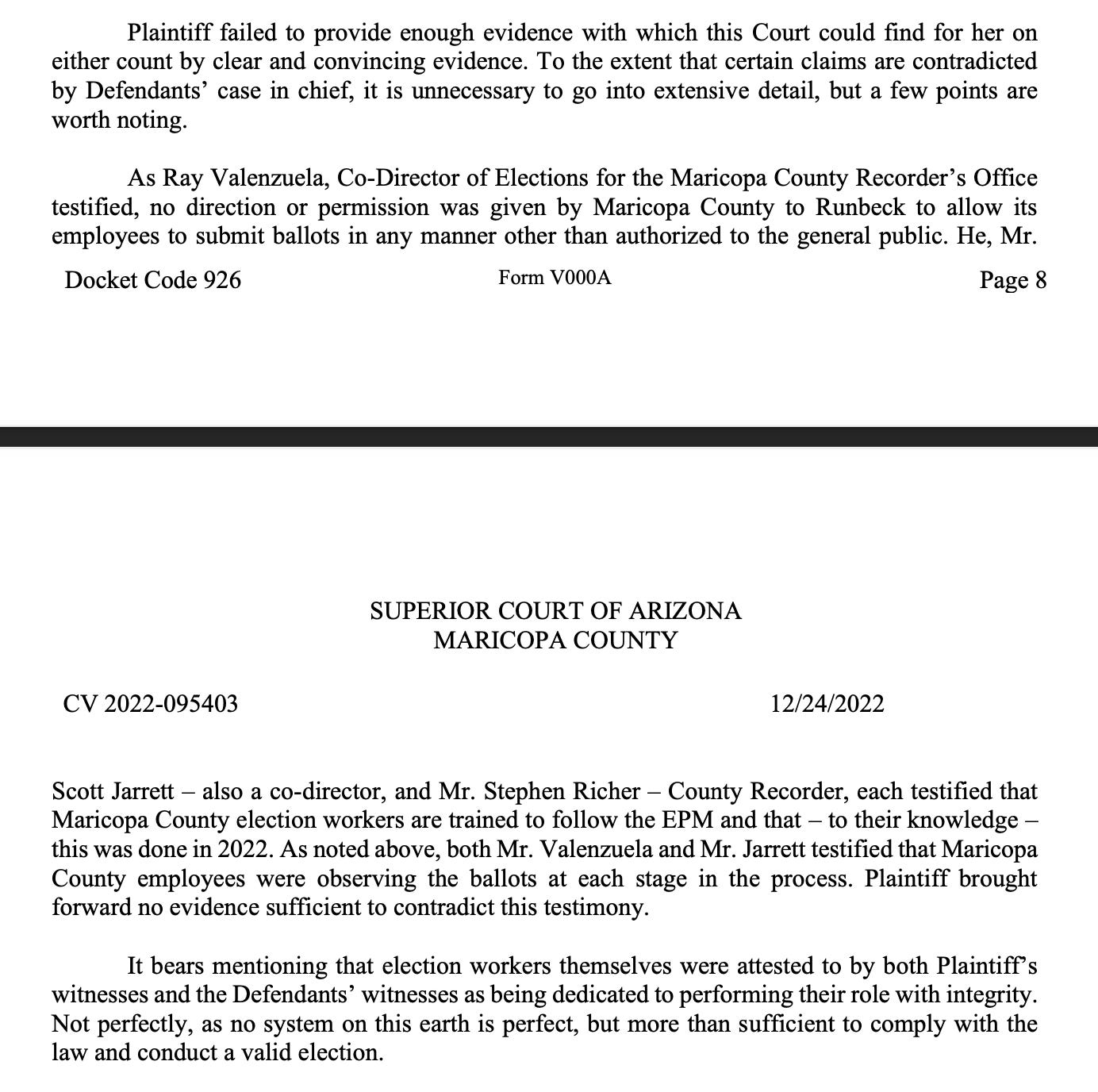Today, in the relative quiet of Christmas Eve, when it was as politically expedient as possible to do so, Judge Peter Thompson released his ruling siding with the defendants in Lake v. Hobbs, ordering the confirmation of Katie Hobbs’ so-called “win” in the gubernatorial race by a margin of 17,117 votes.
Thompson chose to enter us into Scenario B in my article outlining the two possible outcomes related to his decision. From that article:
Caving to pressure, Judge Thompson punts and scoffs at the defense for bad behavior, but says something along the lines of his dismissal of Count III (Signature Verification) in Lake’s case – “due to the fact that the transition is already in motion, the vote is certified, so we can’t change that in this court, but I am ordering…”
This will rightfully piss off two-thirds of Americans, especially those who are newly red-pilled with eyes wide open at how deliberately and meticulously their votes are being ripped off. It will no longer be safe to be a Republican who says a “Trump cult” is obsessed with imaginary election fraud, and the slow march toward what began with the 1770 Boston Massacre will accelerate here in the present time.
I see no scenario in which Judge Thompson punts the case, which would certainly be appealed to the U.S. Supreme Court, that doesn’t dial the temperature in America up to a point that would make November 2020 look like a time of national unity and togetherness.
Thompson, regardless of whether he adhered to technicalities in rendering his decision, has now joined Mark Brnovich, Doug Ducey, and countless others in the ranks of feckless Arizonans who failed to be etched in history as courageous men who acted boldly when the Republic counted on them to put a halt to corruption that threatens the existence of not only the state, but America herself.
Watch the trial again. Thompson knows Hobbs is an illegitimate winner, and that her defense had its ass handed to it by Kari Lake’s legal team, spearheaded by Kurt Olsen. You can see it on the Judge’s face as he hears evidence outlining what was, in all but plain admission, a deliberate attempt to sabotage the election outcome in favor of four Democrat statewide candidates, Hobbs included. He then bore the disgrace of being screeched at by Maricopa County’s hectoring attorney, Thomas Liddy, who is yet another Arizona “lifelong Republican” who does little but carry water for Democrats, and verbally abuse people who ask simple questions in search of transparency.
This article does not seek to determine whether Thompson was blackmailed, bribed, or threatened (probably at least one, if not all). Of course the burden is tremendous, but I don’t give a rip about that, because you shouldn’t be in the kitchen if you can’t take the heat. No judge wants to be the first to overturn a fraudulent election post-2020, especially one of such magnitude that it would launch a likely first female president (Lake) into political orbit. But nevertheless, some judge is going to have to put it all on the line, judicial aspirations and reputation included, at some point if we are to ever have a system of elections even a simple majority of Americans can trust.
You shouldn’t expect Kari Lake or her team to make any comments about the judicial corruption so long as the appeals process is ongoing. There is no need to equip the enemy with soundbites to trot out in the next court that paints the plaintiffs as contemptuous of the entire judicial system; therefore, I will shoulder the burden and dice apart the contradiction-filled decision that came down today in ten pages.
Page 1
Thompson sets the stage for his big punt:
Throughout the history of Arizona, the bar to overturn an election on the grounds of misconduct in this State – or Territory – has always been a high one.
Thompson cites an 1887 case, Sherman v. Board of Supervisors, Mohave County, that practically says election fraud cases don’t matter unless an irregularity affects the result (accurate margins be damned).
Page 2
(excerpt pictured below)
An 1898 case, Oakes v. Finlay, likely bolsters Thompson’s position to do absolutely nothing in that it leaves much open to interpretation with the phrasing “most clear and conclusive character” to describe the burden of proof, which was passed on from an 1893 Utah case (Lake’s team was crystal clear in outlining the fraud, and the defendants constantly trapped themselves in their own pit of lies, to no avail).
Thompson is certain to not only reaffirm that the burden of proof is on the challenger (Lake), but that courts have to assume defendants accused of misconduct “must presume the good faith of their official conduct as a matter of law.” I am all for innocent until proven guilty, but this pillar of state law gives great cover for malfeasance when the very existence of our Republic came from the longstanding reality that men in power generally do everything they can to stay in power, and often become corrupt.
The judge affirms the narrow statutory requirements set forth by the Arizona legislature, and writes “…Plaintiff has no free-standing right to challenge election results based upon what Plaintiff believes – rightly or wrongly – went awry on Election Day.” In a sense, you have everything you need to know on page two – that with such a high burden of proof for overturning an election in the state, political parties seeking power would be foolish not to commit widespread election fraud if they couldn’t win, or even get within ten points of winning, without it.
Page 3
(excerpt pictured below)
Thompson spells out the four elements that must be proven within both claims (Counts II and IV) that were advanced to trial – that the printer irregularities and failure to abide by county election procedures were intentional, that the misconduct was on behalf of someone directly involved with the canvass, that the misconduct was meant to change the result of the election, and that it did change the result. As you can see, the burden is loaded with technicalities and with every reason for a judge to punt absent a confession on the witness stand (which we practically had).
Thompson rattles on and begins to lose his bearing. He writes that setting aside the election result would be of monumental importance, given that the margin is outside the scope of a required recount (how ironic), and gets political, referencing the current debate about election legitimacy (Cliff’s Notes – elections in this country are rightly distrusted by more than 60% of Americans).
The whopper:
The Court acknowledges the anger and frustration of voters who were subjected to inconvenience and confusion at voter centers as technical problems arose during the 2022 General Election.
I can assure you that if these technical problems arose in the barrios of urban Phoenix that prohibited 15,000 to 30,000 heavily Democrat voters from voting, the relief would have been immediate and provided by the county itself.
Pages 4-8
Judge Thompson dispenses with the pleasantries and starts dinging the same witnesses who had him wide-eyed and seemingly red-pilled just a few short days ago.
M. Sonnenklar – Attorney who testified as to the approximate failure rate and impact of electronic voting equipment on Election Day, November 8.
The judge, surprisingly for a ten-year veteran of the U.S. Army Reserve, states “…the Court cannot follow Mr. Sonneklar to ascribing intentional misconduct to any party.” Let me get this straight – you mean to tell me Maricopa County’s Board of Supervisors, Recorder, and other prominent officials of both parties have been openly critical of Kari Lake and the “MAGA” agenda, and know Lake won her primary over substantial fraud thanks only to massive election day turnout in the August 2 primary, Maricopa County kept partisan voting heat maps, and on Election Day, with greater than 3:1 Republican over Democrat turnout, with months to get ready, only then did they have massive failures? All the defense must do is say, “I didn’t do it?” I do not consider the county dispatching technicians to “fix” these issues as an indication they ran their election in good faith. In fact, I would expect any arsonist to act as if he had a vested interest in extinguishing a fire if he didn’t want to be caught.
H. Honey – Auditor and consultant who testified regarding chain of custody failures
Thompson again alleges no misconduct can be inferred to the chain of custody failures cited, such as the county not providing delivery receipt forms pertaining to ballots dropped in drop boxes on Election Day, and Runbeck employees inserting “family and friends” ballots into the count against the law. Judge Thompson once again sides with the fox guarding the henhouse when he affirms the sworn testimonies of Rey Valenzuela, who is the director of Maricopa County’s third-world mail-in voting system, and Scott Jarrett, the county’s director of elections, while discarding an affidavit supporting Honey’s positions. As a final jab, Thompson feigns ignorance about Maricopa County’s fluctuating “unofficial” ballot count on Election Night, as if the county had no idea how the returns needed to be shorted, beefed up, or otherwise altered to achieve the desired outcomes.
C. Parikh – Cybersecurity expert for Northrup Grumman who testified about ballot sizing and printer failures
(excerpt pictured below)
Parikh testified by expanding on Dan Sundin’s big catch from last month, that tabulators failed to read 19” ballots printed on 20” paper, causing misreads and for the ballots to be sent to “Door 3” for duplication or adjudication. The judge hails the Door 3 option, once again, as if voters have great reason to trust Maricopa County after their abject failure to run elections with any degree of competency, as proven in the 2021 Maricopa County audit. The judge tosses Parikh’s testimony for the same reasons he threw out the other two – because the defense didn’t corroborate the testimony. I do not recall 19” ballots being an issue during the lengthy early voting period.
D. Betencourt – Temporary technician employed by Maricopa County who testified as to the maintenance/repair processes required on Election Day
After hailing Maricopa County for dispatching these technicians, Thompson squashes Betencourt’s testimony even after admitting his fifth point, adjusting printer settings, meshes with intent to manipulate election processes, choosing to instead focus on Betencourt’s admissions that technicians sent to the field worked diligently to remedy issues (that is what employees who hope to collect a paycheck and secure future employment generally do).
R. Baris – Pollster and Director of Big Data Poll
Baris provided quantifiable data suggesting just how many voters were disenfranchised by the Election Day machine failures. He is among the greatest at estimating impact in real-time of ongoing vote drops and has been for several cycles, but his reputation for accuracy is now suffering harm thanks to widespread election manipulation nationwide. The judge tosses Baris’s testimony because he couldn’t give a specific number on how many voters were disenfranchised – again skirting the main point, that voters were disenfranchised thanks to the criminal election administration of Maricopa County, to ignore everything based on technicality. Baris is absolutely correct, even while not considering all the fraudulent votes that trickle in during the early voting period, that Lake’s Election Day surge would have overcome it regardless had her voters not been discouraged from voting by hours-long lines and distrust of the ”Door 3” option.
Pages 8-9
Like a home plate umpire growing weary in the heat of a July day game, Thompson is clearly trying to wrap it up by the time the reader reaches Page 8. He states definitively:
Plaintiff failed to provide enough evidence with which this Court could find her on either count by clear and convincing evidence.
Meanwhile, Judge Thompson had no problems whatsoever taking Maricopa County’s words at face value based on the previously mentioned guideline that government workers in their official capacity are to be given benefit of the doubt. Both Valenzuela’s and Jarrett’s testimonies are mentioned here to negate what was brought by Lake’s witnesses. Stephen Richer is mentioned here, in that he said county employees were trained to follow the procedures manual.
So you mean to tell me that all a defendant has to do is say they didn’t do it, and they are good to go?
Conclusion
Judge Thompson decided to play it safe and “punt” the ball, given that either side was going to appeal his decision, no matter what. I will be frank – this judge lacked the courage to do what was right. The defendants’ legal team lied their asses off and were embarrassed and caught off guard throughout the two-day trial. “No, your honor, we didn’t do that on purpose,” or “Yes, that’s too bad that a 3:1 Republican turnout was disenfranchised because the ballots just happened to be printed incorrectly and the machines didn’t work right – we only had three months to get ready for this race,” pass as reasons to get off with ease as nearly three-quarters of Americans side with Lake in believing that Maricopa County botched their own election and purposely disenfranchised voters.
I personally do not care what kind of pressure the Judge was under. He knew that was a risk when he accepted Governor Jan Brewer’s appointment more than a decade ago, just like all veterans understand that their defense of the Constitution may require the sacrifice of his or her own life. At some point in time, some judge will be the first to overturn a fraudulent election. He or she will have to make that decision with at least a modicum of doubt present, particularly when dealing with lies of the defrauding party.
It is particularly interesting to me that Judge Thompson fails to detail the relief on Page 3. The relief does indeed request that the election be set aside, but another option other than Lake being named the winner was fronted, and that was to require Maricopa County to re-do their election. With so much doubt present in the minds of voters, and with so much evidence all but guaranteeing there was pre-meditated election manipulation, why not issue an order for a new election? That would disenfranchise no one, and in fact, would protect the rights of the minority, the so-called “losing” party from the first round of the tainted election.
Judge Thompson lacked the guts to do the right thing, and now he will have to live the rest of his life knowing what he knows, that the election is mangled garbage, and absent relief from a higher court, that his own hand enshrined Katie Hobbs as Arizona’s next governor, which will surely lead the state to ruin. A re-do of the election would allow Hobbs the chance to show her opponent up, and Lake’s voters the fair opportunity to compete on an even playing field. The risk of riots and left-wing violence do not equal the risk to society by leaving this wound to fester.
His moral failure to play it safe and punt and seek refuge to the letter of laws that are only relevant to a lawful, God-fearing, and moral society, puts Arizona on a course to destruction, and by extension, the Republic. The lawless among us have found a way to nearly legally steal elections without recourse available to the injured parties.









Great analysis Seth. An election redo would not solve the problem unless it is done without machines, on paper ballots. Voter ID one day of voting- using all of your 10 points. Also Katie Hobbs can not be in charge of certifying her own election.
Wish you could have litigated this case, Seth. Such a clear opportunity to get things righted! Very disappointing. The attorneys for Lake should have spelled out the consequences for overlooking the evidence that there was malicious intent in this case as you did. You called it: no courage.